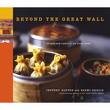 As if I didn’t have enough lovely fiction to read, my favourite cookbook writing duo, Jeffrey Alford and Naomi Duguid have come up with a new one, Beyond the Great Wall: Recipes and Travels in the Other China (Artisan, 2008), which i simply had to buy. When I say I am a fan, I’m not kidding. The Seductions of Rice was the first book of theirs I received, followed by Flatbreads and Flavors and Hot Sour Salty Sweet, abut the cuisines of South Asia. Then last spring, I was searching for meaning in the cookbook aisle and I thought to myself, how wonderful it would be if they wrote a book for India like the one they had done for South Asia. I looked up and, lo, there was Mangoes & Curry Leaves.
As if I didn’t have enough lovely fiction to read, my favourite cookbook writing duo, Jeffrey Alford and Naomi Duguid have come up with a new one, Beyond the Great Wall: Recipes and Travels in the Other China (Artisan, 2008), which i simply had to buy. When I say I am a fan, I’m not kidding. The Seductions of Rice was the first book of theirs I received, followed by Flatbreads and Flavors and Hot Sour Salty Sweet, abut the cuisines of South Asia. Then last spring, I was searching for meaning in the cookbook aisle and I thought to myself, how wonderful it would be if they wrote a book for India like the one they had done for South Asia. I looked up and, lo, there was Mangoes & Curry Leaves.
Why do I like their books so much? Two reasons. First, they’re political. Their attitude towards food and eating is one of both delight and responsibility in a world of scarcity. Their way of eating urges the western world away from making costly (in so many ways) meat the centre of our diet and towards thinking of meat as a delicious accent to a diet based in vegetables and staples like bread and rice. In addition to being guardians of resources, and no more so than in this most recent book, they are guardians of cultures. They are photographers and essayists as well as fine cooks and their stories and pictures document and defend little known cultures and peoples.
The second reason I love their books is that the food is delicious. The receipts typically have modest lists of ingredients and they always work. I admit that my pantry may be better stocked with unusual ingredients than most, but almost everything in their latest book can be made with things you’d find at an ordinary grocery store. It isn’t “restaurant” ethnic food; it tastes more like home cooking, and it is often based directly on dishes they have eaten on their travels, with ordinary people. The classics make way for unusual and unique receipts and their books will not duplicate anything else you have in your collection.
But why take my word for it? I thought I’d make one of their receipts and present it here for you. So, below the fold: Savory Boiled Dumplings!
What follows isn’t the receipt as it appears in the book, but rather the way I made it, which differs a little. First the wrappers:
- 1 1/2 all purpose flour
- 1/2 tsp. salt
- 1 large egg
- about 3/8 lukewarm water
Put the flour, salt, and egg in the bowl of a food processor, turn it on, and pour the water through the feeding tube. The dough shouldn’t be too sticky. Let it sit for an hour while you make the filling:
- 1 small leek
- 1/2 cup ground pork
- 1/4 tsp. salt
- 1/2 tsp. soy sauce
- 1/4 tsp. roasted sesame oil
Quarter the leek lengthwise and slice it thinly. Measure out about 1/2 of leek and put it in a bowl with the other ingredients. Mush it all up with the back of a fork.
Divide the dough into four pieces. Roll one into a log abut 8″ long, reserving the other three. Cut the log into eight pieces. With fingers and rolling pin, press each piece into an oval about 2″ by 3″. Put around a teaspoon and a half of filling on the oval, and pinch up the edges to enclose it like a calzone. No need for extra water — this dough is soft enough without it. Put each formed dumpling onto a cookie sheet covered in wax paper that has been sprinkled with a little flour (that tip alone made the book worth its price. My dumplings always used to stick together). Repeat with the other 3 lumps of dough.
Here’s where I really diverged from the receipt. They suggested boiling the dumplings in water and then straining them. I boiled my in homemade chicken stock with some ginger slivers and the rest of the leek. They cook in a couple of minutes, and I served them in a shallow amount of stock. I made a dipping sauce of 2 parts soy sauce, 1 part rice vinegar and a few more ginger shreds, and on the side I made a salad of chopped cucumber and tomato dressed with salt, lime juice and dill, also inspired by the book. The dumplings were yummy and chewy, fulfilling all my dumpling dreams. And how did they look? Well, see for yourself:

